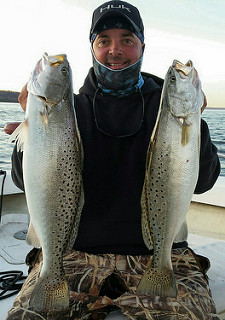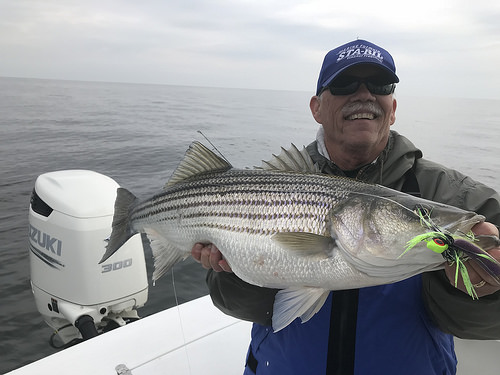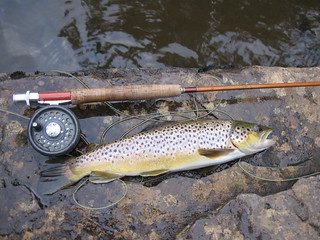Weekly Fishing Report: December 13
Winter’s grasp on the Maryland landscape is steadily getting tighter and windows of mild weather are becoming less frequent. This week high winds could make for a tough time on open water. If you do go out, be careful and wear your life jacket.
Trolling along deep channel edges in the upper Chesapeake Bay region has become the most popular and productive way to fish for larger resident striped bass this week. The fish that measure longer than 20 inches tend to be holding in about 40 feet of water. Hefty inline weights are being used to get tandem rigged lures or umbrella rigs down close to the bottom where fish are holding. A mix of parachutes, swimshads, bucktails, red surge tube lures and spoons have been popular choices. Water clarity has been very good, so white has been a good color to use for lures, as are silver spoons. Now that some large fall migrant striped bass have shown up in Maryland waters, anglers could reap huge rewards placing a couple of large parachutes or spoons in a trolling spread.
Jigging is still a viable option for light tackle anglers in the upper bay, and this time of the year a good depth finder is one of the most valuable tools on the boat. The fish tend to be on the move and one channel edge can be good one day and the next day the fish are gone. It will take some poking around to find them but when you do, there is nothing like light tackle jigging. Large soft plastics in the 8-inch size range have been the most popular lure. The Bay Bridge piers, abutments and rock piles have been one of the more reliable places to look for striped bass stacked up in about 40 feet or more of water. There are large white perch holding there as well.
Before we get into this week’s fishing report, I wanted to remind everyone that they can submit their own fishing reports and photos to the Maryland Angler’s Log. To post a report, please email your name, hometown, photos, location information and additional content for your report. All information is optional, but encouraged. New reports are posted daily during the busy fishing seasons.

Rich Watts is very happy indeed with this pair of hefty speckled trout that had their noses in the discharge plume. Photo courtesy of Rich Watts
At the mouth of the Susquehanna River and up to the dam pool, trolling shad rap type lures has been the ticket to catch the striped bass that are holding there. The throwback ratio can be high at times but most anglers are catching a keeper or two per outing. Very little water has been coming through the dam so clear water prevails and surface water temperatures are holding around 46 degrees.
Surface water temperatures in the middle bay region are holding around 48 degrees this week and steadily dropping. There is very little surface action now in regards to striped bass and schools of bait. Baitfish now come in the form of menhaden and a collection of hickory shad and river herring young of the year that are trying to make their way down the bay.
Trolling has been very popular for the past week or so along some of the deeper channel edges in the bay. The western edge of the shipping channel from Thomas Point south to the Calvert Cliffs Power Plant has been one of the most productive places to troll. The striped bass are holding at about 40 feet along the channel edge, close to the bottom. It will take inline weights to get lures down close to the bottom. Anglers are using umbrella rigs and tandem rigged lures of medium and large sizes. Swimshads, spoons and bucktails are common items trailing behind umbrella rigs. Large parachutes and spoons should also be a part of everyone’s trolling spread now that large fall migrant striped bass are in the region. These big fish like big baits such as adult-sized menhaden so large parachutes and spoons are a good item to be pulling behind your boat.
Jigging is a good option along these same channel edges, where fish can be found suspended close to the bottom. The best option is using large soft plastic jigs in the 8-inch or larger category. Now that water temperatures are chilly, checking out the Calvert Cliffs Power Plant warm water discharge is a good idea. There always seems to be some fish hanging out there bathing, in the warm water discharge.
The lower bay region is providing good fishing for a mix of resident and fall migrant striped bass this week. Trolling has been one of the more popular ways to fish this week along the 40-foot channel edges of the lower Potomac River and the bay shipping channel. The steep channel edge from St. Georges Island south to Point Lookout and the mouth of the Potomac over to Smith Point has been a very good place to fish. Most anglers are trolling a mixed spread of medium and large baits behind inline weights. Parachutes in white with a bit of chartreuse are reported to be a hot bait, and large silver spoons have been accounting for a lion’s share of the large fall migrant striped bass that are being caught. Umbrella rigs are also a part of most trolling spreads. The western side of the shipping channel near Cove Point has also been a good place to troll. These same areas are also good places to jig with large soft plastic jigs, when fish can be found suspended close to the bottom at about 40 feet.
White perch are being found in about 40 feet of water or more in the lower sections of the tidal rivers in all regions of the bay. The white perch tend to hold over oyster bottom and can be caught on a bottom rig baited with bloodworms or small dropper flies. Small striped bass in the 12-inch or greater size range tend to be holding in the same areas.
Weekly Tidal Fishing Conditions Forecast – Dec. 13-20
Continued cold, windy conditions this week should result in dropping surface water temperatures for bay gamefish still remaining in Maryland waters. The Maryland portion of the bay continues to have a well-mixed water column with suitable oxygen conditions from surface to bottom. However, there are slightly warmer bottom water temperatures so anglers may want to scan these deeper channel areas for fish.
As a new feature, you can now see temperature and oxygen levels by depth. Just click on any station on the Temperature by Depth map or the Don’t Fish Below this Depth map.
Main bay surface water temperatures have dropped to the upper 40s with the coolest waters found in the upper bay and upper Potomac River near the Woodrow Wilson bridge. The warmer waters are found from the Gooses Reef south (48 degrees) to the mouth of the Potomac River (48 degrees). Water clarity is generally good with still some reduced water clarity areas along the western shore from the Bay Bridge down to Chesapeake Beach and also on the Potomac near Cobb Island. Expect normal to below normal flows for streams and rivers entering Maryland’s portion of the bay. There will be excellent tidal currents conditions all week as a result of the upcoming new moon Monday.
For the full weekly fishing conditions summary and more detailed and up-to-date fishing conditions in your area of the bay, be sure to check out Eyes on the Bay’s Click Before You Cast. Since this is a new feature for Chesapeake Bay anglers, drop us a line with comments or suggestions.
As cold weather continues in the western region of Maryland and the waters of Deep Creek Lake cool, there may be ice fishing conditions in January. In the meantime, anglers fishing the open waters of the lake are enjoying good fishing for a mix of walleye and yellow perch. The steep rocky drop offs along the shorelines offer some of the best fishing. The walleye are being caught on diving jerkbaits small soft plastic jigs and good old minnows. Drifting minnows close to the bottom is also an excellent way to catch yellow perch and sometimes a smallmouth bass.
Most of the rivers and streams in western Maryland are running low and clear, which can make for difficult fishing, putting conditions in the fish’s favor. This is especially true when fishing skinny water for trout. Approaches must be carefully thought out and long casts are a norm. When fly fishing, a black caddis is hard to beat, as are streamers retrieved in a slow but erratic manner.
The upper Potomac is running low and walleye fishing has been good lately. Recent electrofishing surveys revealed a catch rate well above the long-term norm for both walleye and smallmouth bass.
Fishing in the tidal portion of the Potomac in regards to largemouth bass has settled into fishing deep hard cover with hair jigs, grubs, blade lures and small crankbaits. The bass are holding deep where the water is just a bit warmer. It will take some enticing to get them to strike, and the strikes will be very subtle. Fishing for blue catfish is excellent this time of the year in the channel areas and it is not hard to fill up an ice chest with them. Fresh cut baits are essential.
Crappie fishing continues to be very good this week in the deeper areas around marina docks, fallen tree tops and deep structure. Minnows or small jigs under a slip bobber provide a good way to catch them. Crappie fishing is also good in many of the lakes, ponds and reservoirs that dot the Maryland landscape, as well as tidal rivers on both sides of the bay.
Chain pickerel are very active in cold water and they are very common throughout Maryland in the upper reaches of tidal rivers and all manner of impoundments. Casting spoons, spinnerbaits, spinners and jerkbaits are all good lures to catch them. One of the best places to fish for them is St. Mary’s Lake between Lexington Park and Leonardtown in southern Maryland.
Fishing in the tidal rivers for channel catfish remains good this week and offers some fun fishing from shoreline spots. Blue catfish can be part of the mix in some areas such as the Patuxent, tidal Potomac and Nanticoke rivers. The lower Susquehanna is an excellent place to fish for channel catfish and also flathead catfish.
The Ocean City area is bracing for cold blustery winds that may carry through the weekend. Surface water temperatures near the inlet are about 51 degrees this week. Surf casters have been soaking cut menhaden baits hoping to tie into one of the large fall migrant striped bass moving down the coast; spiny dogfish and a few striped bass under 28 inches have been the only takers. To date the closest reported catch of a large striped bass has been off Indian River Inlet and most catches are above Cape May, New Jersey. A few boats have been trolling off Maryland beaches with no fish reported.
There continues to be some fun striped bass fishing at the Ocean City Inlet and into the back bay regions up to the Route 90 Bridge. Most all of the fish being caught are under 28 inches in length but offer plenty of fun, light tackle catch-and-release action. Topwater lures and swimshads have been the most popular lures.
Anglers climbing aboard party boats headed out to the wreck and reef sites have been catching their limits of sea bass. At times the throwback ratio can be high but at some sites the size of the sea bass can be rather large. Large flounder are still part of the mix, along with bluefish at times. Deep-drop fishing has been good for tilefish, and another opah was caught last week. A southern New Jersey boat stopped into an Ocean City marina to gas up before heading back home with a large swordfish on board. It was weighed at the boat’s home port at a whopping 473 pounds.
“Quite possibly this is the key to fishing: the ability to see glamour in whatever species one may fish for.” – Harold Blaisdell
 ABOUT THE AUTHOR Keith Lockwood has been writing the Fishing Report since 2003 and has had a long career as a fisheries research biologist since 1973. Over the course of his career he has studied estuarine fishery populations, ocean species, and over a decade long study of bioaccumulation of chemicals in aquatic species in New Jersey. Upon moving to Oxford on the eastern shore of Maryland; research endeavors focused on a variety of catch and release studies as well as other fisheries related research at the Cooperative Oxford Laboratory. Education and outreach to the fishing public has always been an important component to the mission of these studies. Keith is an avid outdoorsman enjoying hunting, fishing, bird dogs, family and life on the eastern shore of Maryland.
ABOUT THE AUTHOR Keith Lockwood has been writing the Fishing Report since 2003 and has had a long career as a fisheries research biologist since 1973. Over the course of his career he has studied estuarine fishery populations, ocean species, and over a decade long study of bioaccumulation of chemicals in aquatic species in New Jersey. Upon moving to Oxford on the eastern shore of Maryland; research endeavors focused on a variety of catch and release studies as well as other fisheries related research at the Cooperative Oxford Laboratory. Education and outreach to the fishing public has always been an important component to the mission of these studies. Keith is an avid outdoorsman enjoying hunting, fishing, bird dogs, family and life on the eastern shore of Maryland.
Want the Weekly Fishing Report sent right to your inbox? Click here to sign up!




 1-888-373-7888
1-888-373-7888 233733
233733